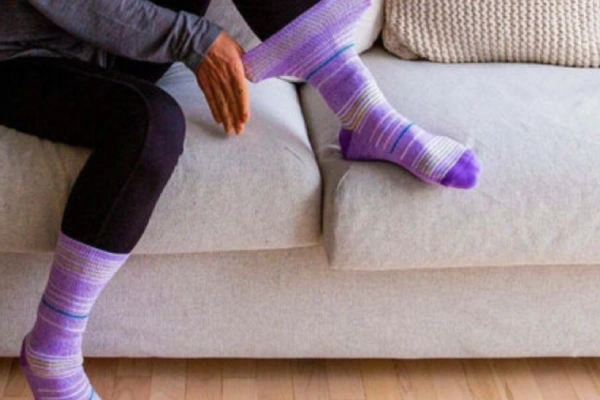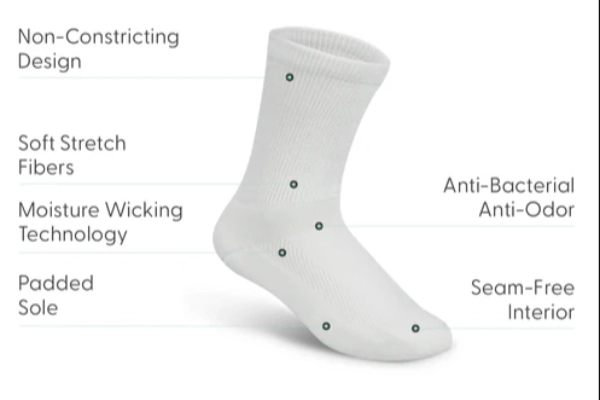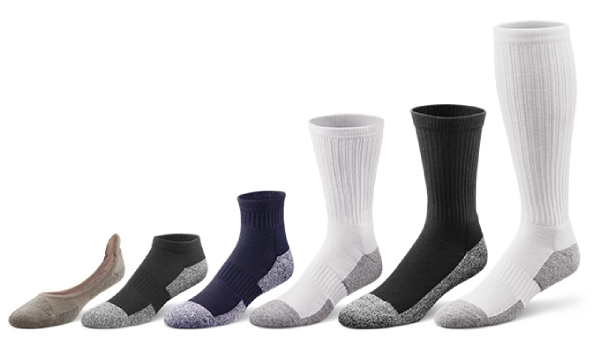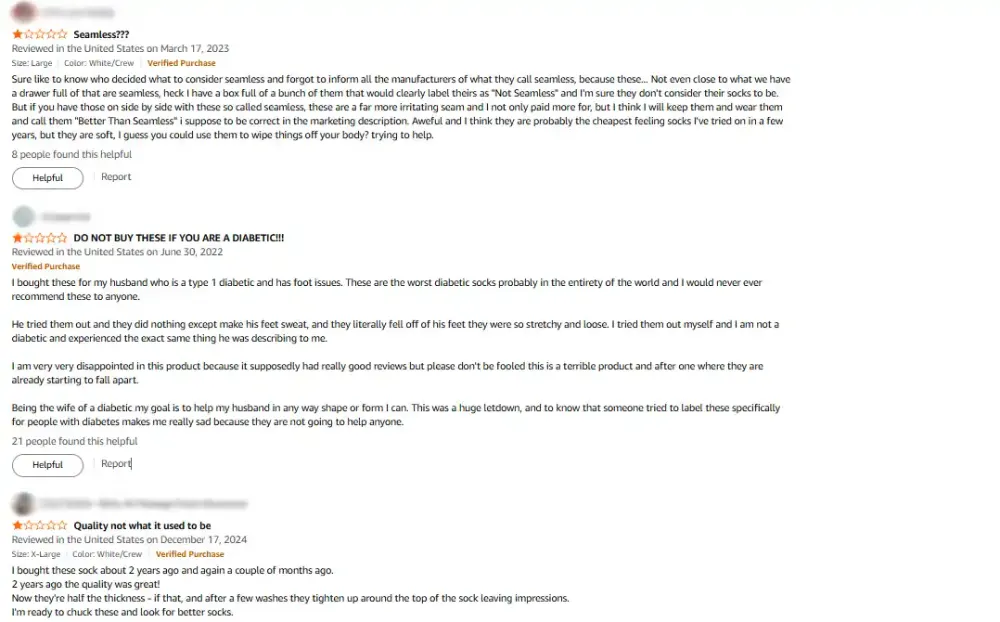
You’ve probably wondered: what are diabetic socks, and how do they differ from regular pairs? Diabetic socks are specialized hosiery designed for people with diabetes or anyone with poor circulation and sensitive skin. They protect fragile feet by combining smart materials with thoughtful knit techniques.
What Are Diabetic Socks? And Do I Really Need Them?

If you’re about to try diabetic socks for the first time—or considering whether you need them at all—these are probably your first questions:
What exactly is a diabetic sock?
Is it truly necessary, or just another marketing trick?
These doubts are common, especially among patients newly diagnosed with diabetes or caregivers choosing socks for elderly family members.
At first glance, a pair of diabetic socks may not appear to be significantly different from regular socks. But look closer at the cuff area and you’ll likely notice something: a looser weave, larger mesh holes, and less visible compression. These design details are intentional, as they allow for better airflow and prevent the sock from digging into the skin—especially important for wearers with poor circulation or sensitive skin.
Unlike compression socks, which are often tight and apply firm pressure to improve blood circulation, diabetic socks focus on protection and comfort. They minimize friction, reduce the chance of pressure points, and help keep feet dry—all critical to preventing ulcers, blisters, or infections.
Diabetic socks aren’t just a trend—they’re a response to the real challenges people with diabetes face daily. If your customers are elderly, have reduced foot sensitivity, or are prone to swelling, these socks are not optional. They’re part of preventive foot care.
Types of Diabetic Socks: Styles & Functional Variants

Ankle, Crew & No‑Show Models
Diabetic socks come in various lengths to suit different lifestyles. Ankle and no-show styles work well for casual or summer wear, while crew lengths offer better protection against friction from shoes and furniture.
Usage Scenarios & Ankle Support Needs
Customers with limited mobility or sensitive ankles often prefer socks with light padding around the heel and ankle. These provide gentle support without tightness, reducing the risk of pressure marks or abrasions.
Zero-Compression vs. Mild Compression
While most diabetic socks are designed with zero compression, mild-compression styles do exist. These help reduce minor swelling in customers with circulation issues—without reaching medical-grade pressure.
Recommendations Based on Neuropathy or Swelling Levels
- Mild neuropathy & minimal swelling: Zero-compression socks with breathable mesh tops.
- Moderate swelling: Mild-compression socks with extra stretch zones.
- Severe cases: Recommend consulting a physician for compression stockings, not standard diabetic socks.
Common Diabetic Socks Problems & Custom Solutions

When diabetic sock users share feedback online, some common issues come up repeatedly. Understanding these helps brands and retailers choose or develop better products.
Wear & Durability Issues
Many users find standard diabetic socks wear out quickly, especially at the heel and toe. Thin yarns or weak reinforcement lead to holes or thinning after a few washes. Custom options with reinforced cushioning or durable yarn blends can significantly extend sock lifespan.
Size & Fit Concerns
Feet affected by swelling or neuropathy often don’t fit standard sizes well. Socks that are too tight can cut off circulation, too loose can cause bunching and blisters. Offering multiple size options and stretchy knit patterns helps accommodate various foot shapes and swelling levels.
Moisture & Hygiene Challenges
Diabetic feet tend to sweat more or stay moist longer, increasing fungal infection risk. Socks made from moisture-wicking and antimicrobial fibers reduce odor and keep feet dry throughout the day, addressing this critical concern.
By addressing these pain points with tailored materials, knit designs, and size options, suppliers can offer diabetic socks that truly meet users’ needs—helping brands build trust and loyalty.
Responding to Real User Needs: Opportunities in Diabetic Sock Development
We recently worked on a custom design for a new product—diabetic athletic socks. The buyer wanted a solution that supports both diabetes care and an active lifestyle. The socks feature breathable, moisture-wicking yarns, seamless toes, cushioned soles, and a soft but secure fit that doesn’t restrict circulation.
This request reflects a broader shift in the market: brands are beginning to respond more precisely to user lifestyles. We encourage more companies to take this proactive approach—identify emerging needs, and create tailored diabetic sock styles that meet them. Being first to address these gaps can help a brand stand out and lead future trends.
Diabetic Socks Quality Standards & Certifications Explained

When buying diabetic socks for resale or medical use, understanding quality certifications ensures you get trustworthy products.
- International & Medical Standards
Certifications like ISO 9001 guarantee consistent manufacturing quality. Testing standards such as ASTM or EN ISO verify compression and stretch performance. Some diabetic socks have FDA clearance if marketed as medical devices. - Material & Safety Certifications
Look for Oeko-Tex Standard 100, ensuring fabrics are free from harmful chemicals. Certifications like OEKO-TEX Microbial prove effective antimicrobial properties. Compliance with Bluesign or EU REACH standards shows eco-friendly dye and chemical use. - Labeling & Claims to Trust
Terms like “non-binding,” “seamless,” or “moisture-wicking” should meet legal definitions backed by third-party testing. Beware of vague marketing claims without certification. Genuine medical-grade socks differ clearly from regular fashion socks.
For more detailed information and examples of certified diabetic socks, please visit our product certification page here.
How to Order Custom Diabetic Socks Wholesale
Diabetic socks provide crucial comfort and protection for users with special foot care needs. Choosing the right materials, designs, and certified quality sets your brand apart. For retailers and brands aiming to serve this market well, customized diabetic socks offer unique differentiation and customer loyalty. Contact us today to discuss how custom diabetic socks can fit your business goals with reliable quality and competitive pricing.
FAQs: Common Questions About Diabetic Socks
What exactly are diabetic socks, and who should wear them?
Diabetic socks are specially designed to protect feet by reducing friction, managing moisture, and improving circulation. They’re ideal for people with diabetes who have nerve damage, poor blood flow, or sensitive skin, but those without foot problems can often wear comfortable, non-binding regular socks.
How do diabetic socks differ from regular socks or compression stockings?
Unlike regular socks, diabetic socks use seamless toes, non-binding cuffs, and moisture-wicking fabrics to prevent irritation and swelling. They differ from medical compression stockings by providing gentle or zero compression rather than tight pressure, making them safer for diabetic foot care.
What features should I look for when buying diabetic socks?
Look for seamless toes, soft and breathable fibers, moisture-wicking and antimicrobial yarns, cushioned soles, and non-restrictive cuffs. These features help protect fragile skin, reduce the risk of infection, and keep feet comfortable all day.
How often should diabetic socks be replaced and how should they be cared for?
Replace socks every 3 to 6 months or when signs of wear like holes or thinning appear. Wash them gently in cold water, avoid bleach or high heat drying to maintain fabric integrity and antimicrobial properties.
Can diabetic socks help with swelling, and when should I consider compression socks instead?
Many diabetic socks provide mild or no compression, helping reduce minor swelling safely. For significant swelling or circulatory issues, medical-grade compression stockings prescribed by a healthcare provider are recommended to avoid harming blood flow.
